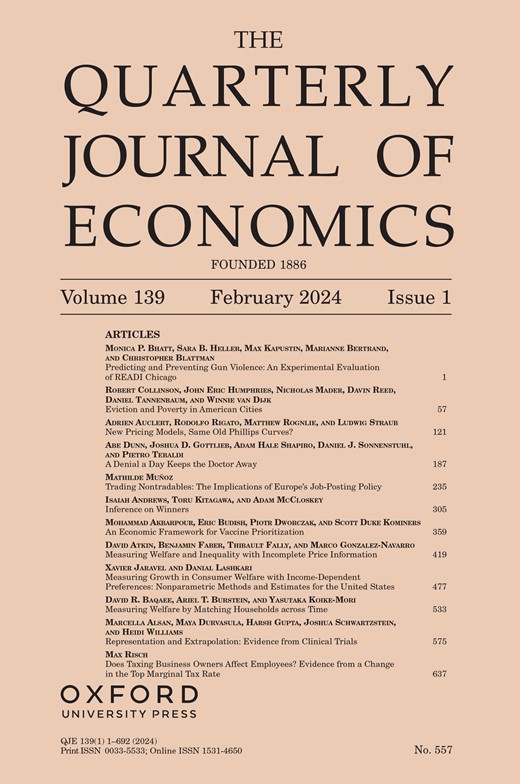美国大学之间的收入隔离和代际流动*
IF 12.7
1区 经济学
Q1 ECONOMICS
引用次数: 160
摘要
我们构建了关于父母的公开统计数据™ 收入和学生™ 使用税务记录中未识别的数据对美国每所大学的收入结果进行分析。这些统计数据表明,大学之间的父母收入隔离程度非常高,与社区之间的情况类似。来自低收入和高收入家庭的孩子在上同一所大学的学生中的毕业后收入差异要比不同大学的学生小得多。收入最好的大学主要招收来自高收入家庭的学生,尽管一些中等水平的公立大学的父母收入水平较低,学生收入较高。将这些收入数据与SAT和ACT成绩联系起来,我们模拟了大学学生分配的变化如何影响种族隔离和代际流动。以考试成绩为条件,使父母收入群体的申请、录取和入学率相等,将大大减少种族隔离,主要是通过增加中产阶级学生在更具选择性的大学中的代表性。然而,这对精英私立大学的低收入学生比例影响不大,因为来自低收入家庭的SAT/ACT分数足够高的学生相对较少。可以通过在申请和录取过程中给予低收入和中等收入学生滑动比例的偏好来消除大学之间父母收入分配的差异,类似于精英私立大学传统学生的偏好。假设80%的学生的观察差异™ 以考试成绩、种族和父母收入为条件的收入来自大学™ 因果效应“这是一个强有力的假设,但与之前的工作一致”这种变化可能会使大学生的代际收入持续性降低约25%。我们得出的结论是,改变学生分配到大学的方式可以大大减少种族隔离,增加代际流动性,即使不改变大学™ 教育项目。本文章由计算机程序翻译,如有差异,请以英文原文为准。
Income Segregation and Intergenerational Mobility Across Colleges in the United States*
We construct publicly available statistics on parents’ incomes and students’ earnings outcomes for each college in the United States using deidentified data from tax records. These statistics reveal that the degree of parental income segregation across colleges is very high, similar to that across neighborhoods. Differences in postcollege earnings between children from low- and high-income families are much smaller among students who attend the same college than across colleges. Colleges with the best earnings outcomes predominantly enroll students from high-income families, although a few mid-tier public colleges have both low parent income levels and high student earnings. Linking these income data to SAT and ACT scores, we simulate how changes in the allocation of students to colleges affect segregation and intergenerational mobility. Equalizing application, admission, and matriculation rates across parental income groups conditional on test scores would reduce segregation substantially, primarily by increasing the representation of middle-class students at more selective colleges. However, it would have little effect on the fraction of low-income students at elite private colleges because there are relatively few students from low-income families with sufficiently high SAT/ACT scores. Differences in parental income distributions across colleges could be eliminated by giving low- and middle-income students a sliding-scale preference in the application and admissions process similar to that implicitly given to legacy students at elite private colleges. Assuming that 80% of observational differences in students’ earnings conditional on test scores, race, and parental income are due to colleges’ causal effects—a strong assumption, but one consistent with prior work—such changes could reduce intergenerational income persistence among college students by about 25%. We conclude that changing how students are allocated to colleges could substantially reduce segregation and increase intergenerational mobility, even without changing colleges’ educational programs.
求助全文
通过发布文献求助,成功后即可免费获取论文全文。
去求助
来源期刊

Quarterly Journal of Economics
ECONOMICS-
CiteScore
24.20
自引率
2.20%
发文量
42
期刊介绍:
The Quarterly Journal of Economics stands as the oldest professional journal of economics in the English language. Published under the editorial guidance of Harvard University's Department of Economics, it comprehensively covers all aspects of the field. Esteemed by professional and academic economists as well as students worldwide, QJE holds unparalleled value in the economic discourse.
 求助内容:
求助内容: 应助结果提醒方式:
应助结果提醒方式:


